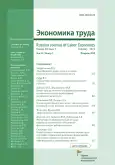Transformation of the labor market in the context of the introduction of artificial intelligence
- Authors: Abdurakhmanov K.K.1
-
Affiliations:
- Tashkent Institute (branch) of Plekhanov Russian University of Economics
- Issue: Vol 10, No 2 (2023)
- Pages: 227-246
- Section: Articles
- URL: https://journals.rcsi.science/2410-1613/article/view/146200
- DOI: https://doi.org/10.18334/et.10.2.117364
- ID: 146200
Cite item
Abstract
Keywords
About the authors
Kalandar Khodzhaevich Abdurakhmanov
Tashkent Institute (branch) of Plekhanov Russian University of Economics
Email: KAbdurakhmanov@yandex.ru
Директор, доктор экономических наук, профессор, Академик академии наук Республики Узбекистан
References
- Abdurakhmanov K.Kh. Features of Development of Digital Economy in Uzbekistan. Special Issue on «Innovative economy: challenges, analysis and prospects for development» Published: 2021-08-07
- Acemoglu D., Restrepo P. The race between man and machine: Implications of technology for growth, factor shares, and employment // American Economic Review. – 2018. – № 6. – p. 1488-1542.
- Aghion, P. et al. (2017), “Artificial Intelligence and Economic Growth”, NBER Working Paper Series, No. 23928, NBER, Дата обращения 14/2/2023 http://www.nber.org/papers/w23928
- Agrawal A., Gans J., Goldfarb A. Artificial Intelligence: The Ambiguous Labor Market Impact of Automating Prediction // Journal of Economic Perspectives. – 2019. – № 2. – p. 31-50.
- American Economic Association Committee on Economic Statistics (ed.) (2020), MeasuringTechnology Adoption in Enterprise-Level Surveys: The Annual Business Survey, Дата обращения 14/2/2023 https://www.aeaweb.org/conference/2020/preliminary/powerpoint/ 7rdEN8G6
- Arntz M., Gregory T., Zierahn U. The risk of automation for jobs in OECD countries: A comparative analysis. OECD Social, Employment and Migration Working Paper 189 (OECD Publishing, Paris). [Электронный ресурс]. URL: www.ifuturo.org/sites/default/files/docs/automation.pdf. (дата обращения: 14.02.2023).
- Bartik T. Who Benefits from State and Local Economic Development Policies?. - W.E. Upjohn Institute, 1991.
- Bessen J., AI and Jobs: The role of demand. NBER Working Paper No. 24235. Дата обращения 14/2/2023 https://www.nber.org/papers/w24235. Accessed March 15, 2019. (2018)
- Bessen J. “The Business of AI Startups”, Law and Economics Research Paper, Boston University School of Law. [Электронный ресурс]. URL: https://scholarship.law.bu.edu/faculty_scholarship/537 (дата обращения: 14.02.2023).
- Bostrom N. “How long before superintelligence?” // Linguistic and Philosophical Investigations. – 2006. – № 1. – p. 11-20.
- Bowles J. The computerisation of European jobs. Bruegel blog. [Электронный ресурс]. URL: bruegel.org/2014/07/the-computerisation-of-european-jobs/ (дата обращения: 14.02.2023).
- Bresnahan T., Trajtenberg M. Bresnahan, T. and M. Trajtenberg (1992), “General Purpose Technologies “Engines of Growth?””. NBER Working Paper, NBER. [Электронный ресурс]. URL: https://www.nber.org/papers/w4148 (дата обращения: 14.02.2023).
- Brynjolfsson E., Rock D., Syverson C. “Artificial Intelligence and the Modern Productivity Paradox: A Clash of Expectations and Statistics”. NBER Working Paper Series, No. 24001. [Электронный ресурс]. URL: http://www.nber.org/papers/w24001 (дата обращения: 14.02.2023).
- Brynjolfsson E., Mitchell T., Rock D. “What Can Machines Learn and What Does It Mean for Occupations and the Economy?” // AEA Papers and Proceedings. – 2018. – p. 43-47.
- Brzeski C., Burk C. Die Roboter kommen: Folgen der Automatisierung für den deutschen Arbeitsmarkt [The Robots are coming: Consequences of Automation for the German Labor Market]. INGDiBa Econ Res 30, 1–7. German (2015)
- Cockburn I., Henderson R., Stern S. The Impact of Artificial Intelligence on Innovation. Nber. [Электронный ресурс]. URL: http://dx.doi.org/10.3386/w24449 (дата обращения: 14.02.2023).
- Dauth W., Findeisen S., Südekum J., Woessner N., German robots – The impact of industrial robots on workers. IAB Discussion Paper 30/2017 (Institute for Employment Research, Nuremberg, Germany). (2017)
- Felten, E., M. Raj and R. Seamans (2019), “The Occupational Impact of Artificial Intelligence on Labor: The Role of Complementary Skills and Technologies”, NYU Stern School of Business, http://dx.doi.org/10.2139/ssrn.3368605
- Frey C.B., Osborne M.A. The future of employment: How susceptible are jobs to computerisation? // Technol Forecast Soc Change. – 2017. – № 114. – p. 254–280.
- Frey C., Osborne M. “The Future of Employment: How susceptible are jobs to computerisation” // Technological forecasting and social change. – 2017. – p. 254-280.
- Griliches Z “Hybrid Corn: An Exploration in the Economics of Technological Change” // Econometrica. – 1957. – № 4. – p. 501.
- Julia, L. (2019), L’intelligence artificielle n’existe pas, FIRST
- McKinsey A future that works: automation, employment, and productivity. Executive summary. - McKinsey Global Institution, 2017. – 28 p.
- McKinsey Survey: AI adoption proves its worth, but few scale impact. [Электронный ресурс]. URL: https://www.mckinsey.com/featured-insights/artificial-intelligence/global-ai-survey-ai-proves-itsworth-but-few-scale-impact (дата обращения: 14.02.2023).
- Mortensen D.T., Pissarides C.A. Job creation and job destruction in the theory of unemployment // Rev Econ Stud. – 1994. – № 61. – p. 397–415.
- Nedelkoska, L. and G. Quintini (2018), “Automation, skills use and training”, OECD Social, Employment and Migration Working Papers, OECD Publishing, Paris, https://doi.org/10.1787/1815199X
- OECD.AI (2023), visualisations powered by JSI using data from Github, Дата обращения 14/2/2023, www.oecd.ai
- Pajarinen M., Rouvinen P., Ekeland A. Computerization threatens one-third of Finnish and Norwegian employment. ETLA Brief 34. [Электронный ресурс]. URL: https://www.etla.fi/wp-content/uploads/ETLA-Muistio-Brief-34.pdf (дата обращения: 14.02.2023).
- Statista 2023. [Электронный ресурс]. URL: https://www.statista.com/outlook/tmo/robotics/industrial-robotics/uzbekistan#revenue (дата обращения: 14.02.2023).
- Webb M. “The Impact of Artificial Intelligence on the Labor Market”. [Электронный ресурс]. URL: https://papers.ssrn.com/sol3/papers.cfm?abstract_id=3482150 (дата обращения: 14.02.2023).
Supplementary files








